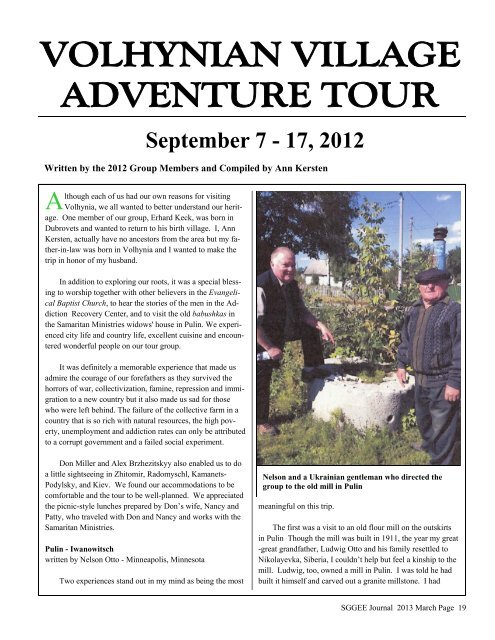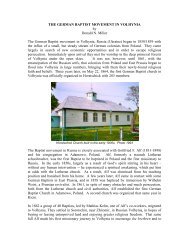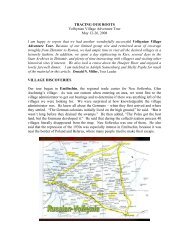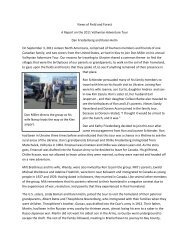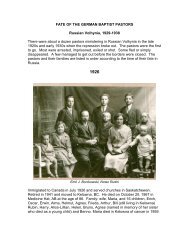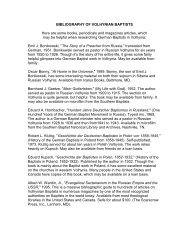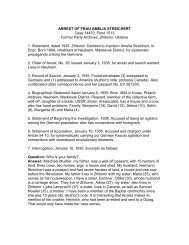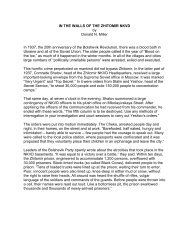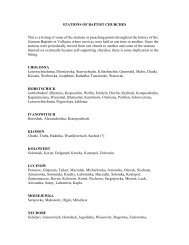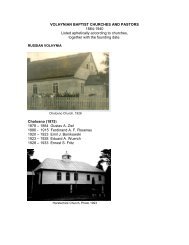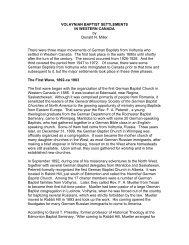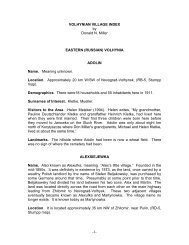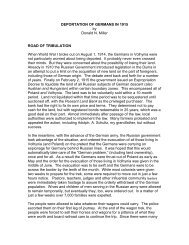You also want an ePaper? Increase the reach of your titles
YUMPU automatically turns print PDFs into web optimized ePapers that Google loves.
lthough each of us had our own reasons for visiting<br />
A <strong>Volhynia</strong>, we all wanted to better understand our heritage.<br />
One member of our group, Erhard Keck, was born in<br />
Dubrovets and wanted to return to his birth village. I, Ann<br />
Kersten, actually have no ancestors from the area but my father-in-law<br />
was born in <strong>Volhynia</strong> and I wanted to make the<br />
trip in honor of my husband.<br />
In addition to exploring our roots, it was a special blessing<br />
to worship together with other believers in the Evangelical<br />
Baptist Church, to hear the stories of the men in the Addiction<br />
Recovery Center, and to visit the old babushkas in<br />
the Samaritan Ministries widows' house in Pulin. We experienced<br />
city life and country life, excellent cuisine and encountered<br />
wonderful people on our tour group.<br />
It was definitely a memorable experience that made us<br />
admire the courage of our forefathers as they survived the<br />
horrors of war, collectivization, famine, repression and immigration<br />
to a new country but it also made us sad for those<br />
who were left behind. The failure of the collective farm in a<br />
country that is so rich with natural resources, the high poverty,<br />
unemployment and addiction rates can only be attributed<br />
to a corrupt government and a failed social experiment.<br />
September 7 - 17, 2012<br />
Written by the 2012 Group Members and Compiled by Ann Kersten<br />
Don Miller and Alex Brzhezitskyy also enabled us to do<br />
a little sightseeing in Zhitomir, Radomyschl, Kamanets-<br />
Podylsky, and Kiev. We found our accommodations to be<br />
comfortable and the tour to be well-planned. We appreciated<br />
the picnic-style lunches prepared by Don’s wife, Nancy and<br />
Patty, who traveled with Don and Nancy and works with the<br />
Samaritan Ministries.<br />
Pulin - Iwanowitsch<br />
written by Nelson Otto - Minneapolis, Minnesota<br />
Two experiences stand out in my mind as being the most<br />
Nelson and a Ukrainian gentleman who directed the<br />
group to the old mill in Pulin<br />
meaningful on this trip.<br />
The first was a visit to an old flour mill on the outskirts<br />
in Pulin Though the mill was built in 1911, the year my great<br />
-great grandfather, Ludwig Otto and his family resettled to<br />
Nikolayevka, Siberia, I couldn’t help but feel a kinship to the<br />
mill. Ludwig, too, owned a mill in Pulin. I was told he had<br />
built it himself and carved out a granite millstone. I had<br />
SGGEE Journal 2013 March Page 19
hoped to locate some tangible connection to the mill. Though<br />
I knew this was not the mill he had built, this was the closest<br />
I came to it. I even imagined that the millstone might actually<br />
have been carved by him.<br />
The second was a visit to the “mother church” in Neudorf.<br />
The church was built in 1907, seated 2000 people, and<br />
was considered to be one of the most beautiful churches in all<br />
of Russia. This is the church w<strong>here</strong> people from miles<br />
around, including Pulin, gat<strong>here</strong>d the first Sunday of each<br />
month. As I walked around in the building, I stopped to linger<br />
on the entrance stairs with the realization that Ludwig and<br />
Barbara Otto, my grandparents, along with their family of ten<br />
children, five boys and five girls, shared the exact same sacred<br />
place. My visit t<strong>here</strong> was over too quickly. I wanted to<br />
linger in their presence.<br />
I had a lot of questions before I went on the tour. I had<br />
even more after the tour. I wish I had been more attentive to<br />
my history when I was younger.<br />
Toporischtsche<br />
written by Ann Kersten - Tucson, Arizona<br />
Toporischtsche sits just off the highway between Zhitomir<br />
and Korosten, about 30 kilometers north of Zhitomir.<br />
This is the village w<strong>here</strong> my husband’s father, Adolph Kersten,<br />
was born. Since we didn’t spot a likely person to give<br />
us directions (a GPS, as we called them) as we arrived in the<br />
village, we went to the village administration building across<br />
the street from the Russian Orthodox Church. Through the<br />
help of a woman working t<strong>here</strong> and another villager, we located<br />
a German man, who still lives in the area, Rheinhold<br />
Fugman. He was born in 1943 in Federowka.<br />
Reinhold Fugman and Ann Kersten<br />
Rheinhold gave us some helpful background information.<br />
He informed us that t<strong>here</strong> were two German colonies<br />
associated with Toporischtsche: Halynowka, a Lutheran colony;<br />
and Komarowka, a Baptist one. He explained that t<strong>here</strong><br />
are four cemeteries in or around the village. He thought the<br />
one most likely used by the German Baptists would be the<br />
one which sits on the boundary between Toporischtsche and<br />
Komarowka.<br />
When we arrived at the huge Ukrainian cemetery, we<br />
found the German section in it to be much as all the other<br />
German cemeteries we visited: overgrown, almost headstoneless,<br />
and having been raided by grave-robbers. Rheinhold<br />
tickled his memory to come up with a few surnames of Germans<br />
who had lived in the area. Eventually, he came up with<br />
Merck, Stoltz (died <strong>here</strong>), Lanz, Shuck, and Julius Lass, who<br />
emigrated to the USA.<br />
Next Rheinhold lead us down a “wagon trail,” w<strong>here</strong> we<br />
parked the vans in a field beside another abandoned apple<br />
orchard. We learned that the German Baptist church and<br />
school had been close by. A stand of linden trees reportedly<br />
marked the former location of the school. Don and I walked<br />
through the weeds until we were within the wooded area. The<br />
linden trees seemed to have been planted in two rows. Rheinhold<br />
told us the church and school had been destroyed during<br />
WWII.<br />
Don Miller points to Linden Trees near Komarowka<br />
I had an “eleventh hour” discovery in the Zhitomir Archives.<br />
I had been told that the East Prussians, the group to<br />
which my father-in-law belonged, had purchased a large tract<br />
of land upon their arrival in <strong>Volhynia</strong>. The land was part of<br />
the village of Toporischtsche. With the aid of my translator,<br />
Natali, we found the record of the purchase of that land in<br />
SGGEE Journal 2013 March Page 20
August 1865 with the signatures of 38 Germans who were<br />
involved in that purchase. I am in the process of trying to get<br />
the document translated. I am sure this will be of interest to<br />
those who have their roots in the same area.<br />
Dubrowetz, Cholosna Tschermoschna<br />
written by Daphne Keck, nee Hofmann<br />
This was a very special adventure for the three Keck<br />
brothers: Erhard, Wilmard and Manfred, to return to Dobrowetz<br />
w<strong>here</strong> Erhard was born and see the farm place and<br />
school of their mother, Tamara Keck (nee Bayer). Uncle<br />
Leonard Bayer, (Tamara's brother) had given detailed instructions<br />
on how to locate the farm yard from the cemetery at<br />
Dubrowetz. The buildings were gone but the pear tree and<br />
apple trees which Uncle Leonard often spoke about, were still<br />
t<strong>here</strong>. We brought home a pear from his tree which we hope<br />
will not be too brown before we give it to Uncle Leonard in<br />
Edmonton.<br />
We knew very little about our father's family, just that<br />
our grandfather, Gottlieb Keck, had been sent to Siberia and a<br />
brother to our father, Waldemar, had disappeared sometime<br />
in the 1930's. Unfortunately, the archival file in Zhitomir for<br />
1911 when our father was born was missing. However, our<br />
translator, Vika, helped us find a record of Julius Keck, who<br />
came from the same area at Krasnich as our father. Julian had<br />
been shot in 1937 for writing a letter to Poland stating that<br />
things were difficult plus the fact that he was considered to be<br />
a kulak, in that he owned 42 hectares of land and six or seven<br />
cows. Apparently, this was considered treasonous and capitalistic.<br />
We were able to get contact information for a granddaughter<br />
of Julian who had written from Siberia in 1996, requesting<br />
information about her grandfather. Hopefully, this<br />
contact will lead us to connections with our missing relatives.<br />
Erhard's wife, Ellie, was able to find records of her Edel<br />
grandfather, as he petitioned, along with other residents of<br />
Cholosna, to purchase the land they were farming in the early<br />
1900's. Daphne, Wilmard's wife, had a surprise when the archivist,<br />
questioned if her Hoffman ancestors were part<br />
of the Hoffman nobility but unfortunately t<strong>here</strong> were no records<br />
found to support that idea.<br />
Traveling the paths through the bush and over the fields<br />
gave us an appreciation for the route our mother, Tamara,<br />
must have taken as she went to school in Tschermoschna and<br />
probably worshiped with other Baptists in the Neudorf<br />
Church. While we had a glimpse of the physical setting, Don<br />
Miller, our tour guide, was able to fill in the political and<br />
historical setting that our parents encountered as Stalin ruthlessly<br />
plundered the area and our Keck parents retreated with<br />
the German army in 1943, and finally immigrated to Canada<br />
in 1948.<br />
Fred, Will, Dephne, Erhardt and Ellie Keck by the cemetery<br />
across from the Bayer Farm<br />
Alex and Don by the old Morgrowka well<br />
SGGEE Journal 2013 March Page 21
three feet by three feet square lined with oak or some other<br />
type of hard wood which had fossilized and turned to what<br />
they called ironwood. The well was spring fed and the water<br />
clear. Alex tasted it and Don suggested that my ancestors had<br />
probably used the spring in the early years of their settlement.<br />
Eddetta and Anton’s Wagon Ride<br />
Morogowka and Karlswalde<br />
written by Eddetta Beier Grant of Sand Springs, Oklahoma<br />
This tour was the trip-of-a-lifetime! The hardest part was<br />
all the flying but it was well worth the loss of sleep.<br />
The trip to the<br />
State Archives in Zhitomir<br />
proved most<br />
interesting and productive.<br />
I was fortunate<br />
enough to find a<br />
record of my Great<br />
Uncle Julius Beier’s<br />
birth in a village I had<br />
not previously heard<br />
of, called Morogowka.<br />
Nothing remains<br />
of the German colony<br />
that once existed t<strong>here</strong><br />
but the tour guide was<br />
able to find a local<br />
resident by the name<br />
of Boris, who led us<br />
to w<strong>here</strong> it had once<br />
been. I stood on the<br />
Tombstone in Tuczyn<br />
ground w<strong>here</strong> the<br />
cemetery had stood<br />
and wondered if this was w<strong>here</strong> my Grandfather Emil Beier’s<br />
younger brother, Benjamin, had been buried after he died at<br />
the age of one year. I definitely felt a connection with that<br />
location.<br />
Boris also told Alex of an old well which we located. We<br />
were told the well was over 100 years old. It was probably<br />
Probably the highlight of my trip was riding in one of the<br />
many wooden wagons like we passed in just about every village<br />
we visited. The last village stop for the tour was that of<br />
Karlswalde w<strong>here</strong> my Great Grandfather, Jacob Karcher, had<br />
once lived. In trying to find directions to the village, we<br />
stopped at one of the roadside markets. Our tour translator,<br />
Alex, went to get directions. A horse and wagon had stopped<br />
at the market. Alex returned and said for 100 grivnas the man<br />
would let me ride in<br />
his wagon part of<br />
the way to Karlswalde.<br />
So, I<br />
climbed into the<br />
wagon and we started<br />
on our journey.<br />
The man’s first<br />
name was Anton.<br />
He chatted up a<br />
storm. I didn’t understand<br />
a word, but<br />
I did keep asking if<br />
we had reached<br />
Karlswalde. Fortunately,<br />
the rest of<br />
the tour group was<br />
following in the<br />
vans so I wasn’t too<br />
worried. Alex had<br />
also found an old<br />
babushka who remembered<br />
playing Harold with Anna Petrovich<br />
with a German family<br />
by the name of Bender. She showed us w<strong>here</strong> the church<br />
had once stood. We also found the wooden cross with some<br />
grave stones which had been found when the fields were<br />
plowed during the collective farm era. T<strong>here</strong> were none with<br />
my family name but it was still a sacred place to me.<br />
It was a wonderful trip and a wonderful group with<br />
whom to share the experience. The trip did indeed turn out to<br />
be a trip-of-a-lifetime. The travel t<strong>here</strong> and back was exhausting<br />
but well worth all the effort that was put into this search<br />
for the past. Don Miller and Alex Brzhesitskyy are to be commended<br />
for such a wonderful adventure.<br />
SGGEE Journal 2013 March Page 22


